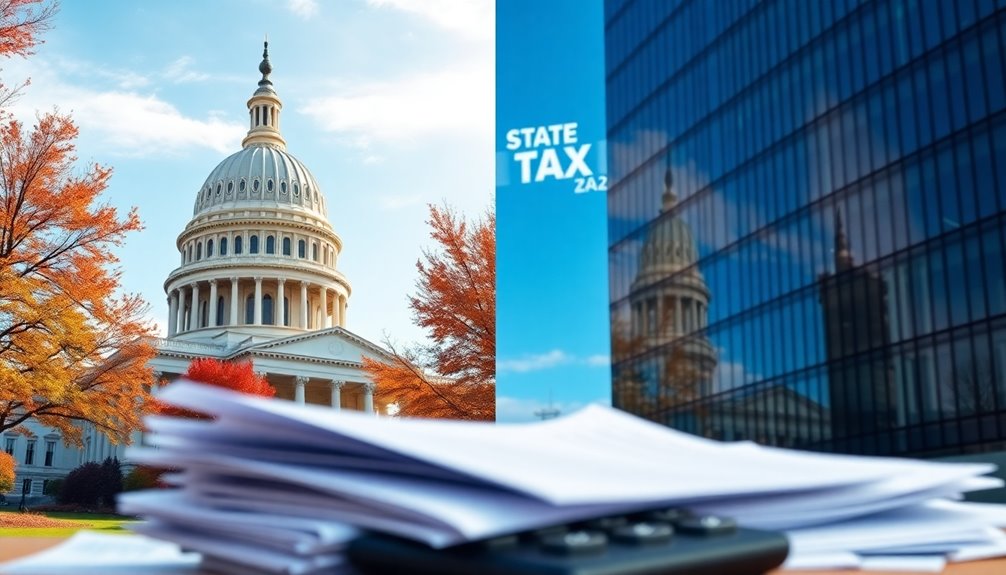To avoid a deadline disaster, know your exact filing date and set reminders days in advance. Gather all your documents, organize receipts, and verify your income sources quickly. Use electronic filing and direct deposit for faster refunds, and consider professional help if your situation is complicated. Staying organized and alert helps prevents last-minute panic—if you keep these tips in mind, you’ll be ready to finish on time and avoid penalties. Keep going, and you’ll learn even more strategies to stay on track.
Key Takeaways
- Use IRS e-file and direct deposit to speed up processing and receive refunds swiftly.
- Gather and verify all income documents and deduction records early to avoid last-minute errors.
- Set multiple digital reminders close to the deadline to stay organized and prevent missed filings.
- Confirm banking details are correct and compatible with electronic refunds to avoid delays.
- Enlist a tax professional for complex situations or tight timelines to ensure accuracy and compliance.
Know Your Filing Deadline and Extension Options

Understanding your filing deadline is essential to avoid penalties and interest. Familiarize yourself with tax extension procedures like filing IRS Form 4868 to gain an automatic six-month extension, pushing your deadline to October 15, 2025. Keep in mind, extensions only apply to filing, not paying taxes owed, which are still due April 15. Be aware of state deadline variations—some regions, such as Los Angeles County and certain counties in Arkansas, Kentucky, Tennessee, and West Virginia, have later deadlines, like October 15 or November 3, 2025. Always check your specific state’s revenue department for extension options. Knowing your deadlines helps you plan ahead and avoid last-minute stress. Missing these deadlines can result in penalties, including late-filing fees and interest, so knowing your federal and state deadlines helps you stay compliant and avoid costly mistakes. Additionally, understanding the importance of color accuracy can help you better interpret visual information in your tax documents and records, ensuring details are correctly reviewed.
Gather and Organize Your Tax Documents Efficiently

Start by gathering all your income statements, such as W-2s and 1099s, to make certain nothing’s missing. Then, sort your deduction documents like receipts and invoices into organized folders for quick access. Finally, double-check that your personal details are accurate and up-to-date to prevent delays or errors. Be aware of family photoshoot fails that can cause last-minute surprises, so prepare contingency plans if needed.
Collect All Income Statements
Gathering all your income statements is a crucial step in organizing your tax documents efficiently. To confirm income source verification and document authenticity validation, collect every relevant form, including W-2s, 1099s, brokerage statements, and rental income records. Keep in mind these key points:
- Check all W-2 forms from employers to verify wages and tips.
- Gather 1099 forms for interest, dividends, freelance work, and retirement income.
- Collect investment statements documenting capital gains and dividends.
- Include records of rental income, alimony, unemployment, or Social Security benefits.
- Properly organizing these documents ensures accurate reporting and simplifies the review process. Additionally, maintaining up-to-date filters and maintenance on air purifiers can help sustain their effectiveness, especially if you rely on them for allergy relief during tax season.
Sort Deduction Documentation
Are you effectively organizing your deduction documentation to guarantee quick access and compliance? Start by sorting your documents into deduction categories like medical expenses, charitable donations, business expenses, and home office costs. Use subcategories such as travel or supplies under business expenses to keep things tidy. Label each folder clearly, including the tax year, to simplify retrieval. Maintain chronological order within folders to find specific documents fast. Separate personal from business deductions to prevent mix-ups and meet IRS rules. Keep original receipts, invoices, and supporting documents, recording details like date, amount, and purpose. Use a consistent document organization system, whether physical folders or digital files, and back up everything regularly. Organizing your files systematically can also help prevent missed deductions and IRS audits. Staying organized now saves you stress and time later, especially during last-minute filing.
Verify Personal Details
Have you organized your tax documents to guarantee quick verification and accuracy? Ensuring document authenticity and smooth identity verification starts with gathering all relevant records in one place. Use a checklist to confirm you have W-2s, 1099s, interest statements, and past returns. Cross-reference your drafts with original documents to flag discrepancies early. Attach supporting forms and schedules for exhaustive personal detail verification. Digitize all documents with clear, legible scans or photos for automated validation. Proper organization facilitates efficient document verification processes. Centralize all required documents before submission, cross-check drafts against original records, attach supporting forms and schedules, and scan or photograph documents for digital backup. Proper organization minimizes errors, speeds up verification, and prevents delays.
Leverage Electronic Filing for Speed and Accuracy

Leveraging electronic filing substantially boosts both speed and accuracy in submitting tax returns. E-file submissions are processed instantly, with acknowledgments arriving within 24 hours, unlike slower paper filings. It also cuts down on physical paperwork and postage, speeding up the entire process. Using e-file combined with direct deposit accelerates refunds from weeks to days. To visualize, consider the benefits:
| Speed Benefits | Accuracy Benefits | Security & Compliance |
|---|---|---|
| Immediate processing | Error rate under 1% | Encryption & secure transmission |
| Faster acknowledgments | Built-in error checks | Digital proof of filing |
| Quick refunds | Automated data input | Confidential data handling |
| Reduced bottlenecks | Real-time error notifications | Updated security standards |
| Faster responses | Detailed error explanations | Automated tracking |
In addition to these advantages, early e-filing provides additional time for clients and preparers to review and address potential issues, ensuring a smoother experience. Implementing electronic filing also helps maintain compliance standards by adhering to current security protocols and data handling regulations.
Verify Your Banking Details for Faster Refunds

Make sure your account and routing numbers are correct before submitting your tax return to avoid delays. Double-check that your bank is compatible with electronic refunds and matches your account details. Confirming these details now can help ensure your refund arrives quickly and without complications. Additionally, verifying your identity through the IRS’s official channels can prevent potential processing delays due to fraud checks. Being aware of electric bike specifications can also help you understand your refund options if you’ve purchased such items related to your tax deductions.
Confirm Account Numbers
Confirming your banking details is a crucial step to guarantee your tax refund is processed quickly and accurately. Proper account verification helps ensure the IRS deposits refunds into your correct bank account, avoiding delays or misdirected funds. To do this effectively:
- Double-check account numbers against bank statements or secure online portals
- Contact your bank directly to verify your bank account details
- Enter your account number carefully, slowly, and without typos
- Confirm that your bank account is active and capable of receiving direct deposits
- Remember, the Dad and Daughter bond is built on trust and understanding, just as verifying your financial details builds confidence in your transactions.
Securing your bank details are correct minimizes the risk of deposit rejection or delays. Avoid using accounts not in your name, as this can cause complications or legal issues. Accurate account verification speeds up your refund and keeps your financial information safe.
Check Routing Information
Verifying your routing number is a key step to guarantee your tax refund is deposited quickly and accurately. Routing validation ensures the nine-digit code matches your financial institution, reducing delays caused by incorrect or outdated information. Always confirm that the routing number belongs to your bank, not an unrelated institution, to prevent fund loss or rejection. Double-check that your account ownership matches the bank account details you provide; the IRS only deposits refunds into your account or your spouse’s if filing jointly. Using a valid, current routing number helps avoid switching from direct deposit to a slower paper check. Additionally, AI security measures can be employed to detect fraudulent banking information and prevent unauthorized refunds. Always obtain your routing information directly from your bank or official documents to ensure accuracy. Proper validation of routing info streamlines processing and speeds up your refund. Contact the IRS if you experience issues with your direct deposit to verify your banking details and avoid delays.
Ensure Bank Compatibility
Are you sure your bank accepts direct deposits for your specific account type? Confirming bank compatibility is vital to avoid refund delays. Some banks have account restrictions or policies that might block refunds or limit account types like checking, savings, or prepaid debit cards. You should also verify if joint refunds are accepted into both individual and joint accounts, as policies vary. Additionally, check whether your bank allows direct deposits into less common accounts like IRAs or HSA accounts. Reviewing the payment processing policies of your bank can help clarify these details. To ensure smooth processing, consider these key points:
- Confirm acceptance for your account type and account restrictions
- Verify if joint refunds are accepted into your account
- Check if your bank accepts direct deposits for special accounts
- Contact your bank to validate routing and account numbers accuracy
Consider Professional Help for Complex Situations

When facing complex tax situations or last-minute deadlines, enlisting professional help can make a significant difference. Tax law complexities can be overwhelming, and professional guidance guarantees your return is accurate and compliant. Tax professionals have extensive knowledge of regulations, allowing them to identify maximum deductions and credits quickly, reducing your tax liability. They’re trained to handle time-sensitive filings efficiently, lowering the risk of costly errors like miscalculations or missed deductions. For intricate cases—such as business income, rental properties, or inheritance—experts provide tailored advice and manage complicated reporting. Hiring a professional not only saves you time and stress but also helps avoid penalties and audits. Their expertise guarantees your last-minute filing is thorough, accurate, and compliant, giving you peace of mind. Incorporating specialized tools like waterwick pots or unique planters can further streamline your process and ensure your workspace remains organized during busy times.
Use Reminders and Calendar Alerts to Stay on Track

Using reminders and calendar alerts is a simple yet powerful way to stay organized and meet deadlines. Digital reminders and calendar alerts help prevent forgetfulness and boost task completion. Here are key tips to maximize their effectiveness:
- Set multiple reminders, including a last-minute alert close to the deadline, to increase your chances of staying on track.
- Use a variety of reminder methods, like SMS, emails, or calls, to reinforce your schedule.
- Include essential details—date, time, location—in your reminders for clarity.
- Schedule alerts well in advance, but also add timely notifications near the deadline for a final prompt.
- 97% of studies show reminders improve attendance rates, highlighting the importance of consistent reminders for meeting deadlines. Incorporating reminder effectiveness can further optimize your planning.
Consistent use of these tools reduces missed deadlines, improves compliance, and keeps you focused, ensuring you avoid last-minute panic.
Understand the Penalties and Consequences of Missing the Deadline

Missing a deadline can lead to serious financial and legal consequences, so understanding the penalties involved is vital. If you file late, you face penalties that can quickly add up, especially with IRS enforcement actions. The late filing penalty is 5% of unpaid tax per month, capped at 25%, and if both filing and payment are late, penalties can combine to reach 47.5%. The failure-to-pay penalty is 0.5% monthly, rising to 1% if IRS issues a final notice, but it can be reduced to 0.25% with an installment plan. Inflation adjustments may increase penalty amounts, making timely filing essential. Penalties for late filing and payment are inflation-adjusted for 2025, which can increase the financial stakes for non-compliance. Being aware of these penalties helps you seek penalty reduction options and avoid escalating fines that could lead to liens, levies, or other enforcement actions.
Frequently Asked Questions
How Early Should I Start Preparing My Tax Documents Each Year?
You should start your tax organization and early planning at least 1-2 months before the IRS filing season begins, around late December or early January. Gathering documents early helps identify missing info and reduces stress. By initiating preparations early, you can review your records, request corrections, and make certain all forms arrive on time. This proactive approach makes the entire process smoother, accurate, and less rushed, leading to a more confident filing experience.
What Are the Most Common Errors to Avoid When Filing Last-Minute Taxes?
Imagine your last-minute tax return as a tightrope walk—you need balance and precision. Watch out for tax software pitfalls, which can introduce errors like mismatched Social Security numbers or incorrect filing statuses. These slip-ups can trigger IRS audits. Double-check all details, especially names, SSNs, and calculations, before submitting. Avoid rushing, and review everything carefully to prevent common errors that could delay your refund or invite unnecessary scrutiny.
Can I Still Get a Tax Extension if I Miss the April 15 Deadline?
If you miss the April 15 deadline, you generally can’t get a tax extension retroactively, but you can still file a late return to minimize penalties. A tax extension must be requested by April 15, and late requests aren’t usually accepted. However, filing late without an extension can lead to penalties and interest, so it’s best to submit your late return as soon as possible, even if the deadline has passed.
How Do I Check the Status of My Refund After Filing?
Did you know over 90% of refunds are issued within 21 days? To check your refund status, use IRS tools like “Where’s My Refund?” on IRS.gov or the IRS2Go app. You’ll need your Social Security number, filing status, and refund amount. The system updates daily, showing stages like received, approved, and sent. Calling doesn’t speed up the process, so check online for quick updates.
What Resources Are Available if I Can’t Afford Professional Tax Assistance?
If you can’t afford professional tax assistance, plenty of free tax help options are available. You can access IRS assistance through Volunteer Income Tax Assistance (VITA) and Tax Counseling for the Elderly (TCE) programs, which offer in-person help from IRS-certified volunteers. Additionally, IRS Free File and Direct File options provide guided online tools for simple returns. Community nonprofits like United Way also offer free tax clinics, ensuring you get the support you need without extra costs.
Conclusion
Missing a deadline can feel like a stumble, but it’s not the end of the road. With these last-minute tips, you can navigate the process smoothly and avoid unnecessary stress. Remember, taking action now keeps your financial journey moving forward without regret. Stay proactive, and you’ll find that even a late submission can be handled with confidence and care. You’ve got this—your future self will thank you for the effort today.









